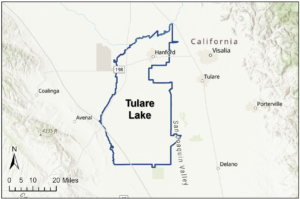 The California State Water Resources Control Board (SWRCB) will consider putting the five agencies that control groundwater in the Tulare Lake Subbasin on probation at a hearing set for 9:30 a.m. on Tuesday, April 16 in the state capital.
The California State Water Resources Control Board (SWRCB) will consider putting the five agencies that control groundwater in the Tulare Lake Subbasin on probation at a hearing set for 9:30 a.m. on Tuesday, April 16 in the state capital.
Placing the agencies on probation is the final step before the SWRCB takes full control of the Tulare Lake Subbasin by imposing its own groundwater sustainability plan (GSP). If the state puts the agencies on probation, they will have one year to correct deficiencies in their GSPs before the state lowers the boom.
The hearing will be in the Coastal Hearing Room of the Joe Serna Jr.– CalEPA Headquarters Building, 1001 I Street, Sacramento. The hearing will be broadcast live on via the CalEPA website at video.calepa.ca.gov.
Five Agencies Could Lose Local Control
The five agencies at risk of losing local control of groundwater are the South Fork Kings Groundwater Sustainability Agency, the Mid-Kings Groundwater Sustainability Agency, the El Rico Groundwater Sustainability Agency, the Tri-County Water Authority and the Southwest Kings Groundwater Sustainability Agency. Between them, the agencies control groundwater throughout the entire Tulare Lake Subbasin, which stretches from just north of Hanford to the Kern National Wildlife Refuge on the western reach of the South Valley.
Nearly 150,000 people live in the region, which includes the cities of Hanford, Lemoore, Stratford, Avenal, Home Garden, Kettleman City and Corcoran in its boundaries. The Tulare Lake Subbasin covers more than 500,000 acres or about 837 square miles.
At issue at the April 16 hearing are unaddressed shortcomings SWRCB has identified in the conservation plans submitted by agencies in order to comply with the requirements of the 2014 Groundwater Sustainability Act. Should the state place the agencies on probation, they will have one year to reshape their plans to meet the state’s requirements.
Failure to do so would likely result in the state taking direct control of the noncompliant agencies and implementing their own GSPs. State control will end only when the SWRCB determines that a sustainable plan is in place.
6-page report details plan’s deficiencies
A SWRCB staff report issued in October of last year details the failures of the GSP offered up by the at-risk agencies.
Most critically, their plan simply failed to provide a means for stopping the chronic depletion of groundwater that has caused the west side of the Valley to sink by dozens of feet. However, a host of other issues are also in violation of the 2014 law’s requirements.
Specifically, the state said the agencies do not adequately address the effect of over-pumping groundwater on public supply wells. The state believes the plan as written would leave 23% of the area’s public supply wells dry if the aquifer falls below the minimal threshold suggested in the local plan for managing the subbasin. Also, about a third of the domestic wells in the subbasin would run out of water, the state said.
“(The Department of Water Resources) notes, moreover, that the sustainable management criteria would likely result in significant and unreasonable impacts to people who rely on shallow wells,” the DWR staff wrote. “Board staff have built on DWR’s analysis, noting the 2022 GSP does not clearly address the likelihood that all wells in the shallow part of the basin could go dry based on the GSP’s approach, nor does it identify the wells that could be impacted by the GSP’s current approach.”
Finally, the five GSAs also ignored the effects of over-pumping on other sustainability indicators, such as groundwater storage, subsidence, degradation of groundwater quality and the depletion of interconnected surface waterways.
For more information about attending the April 16 hearing online and making public comments, visit waterboards.ca.gov/board_info/remote_meeting/.
